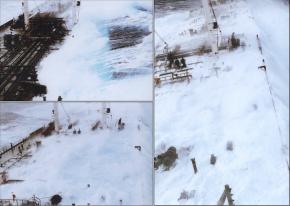Title
Weird Science: Rogue Waves
NGSS Crosscutting Concepts
Rogue waves have been a part of mariner legends and stories for centuries. Sailors have told tales of 30 m waves that destroyed ships. Observers say that rogue waves look like walls of water with unusually large troughs. However, until recently, there was little evidence to gauge how big rogue waves actually get. Now satellites and improved wind and wave monitoring have helped to document rogue waves and improved our understanding of them.
SF Fig. 4.7. In 1993 a rouge wave hit the tanker Overseas Chicago on the starboard side as it headed south from Valdez, Alaska. The ship was running in about 8 m seas, the rouge wave swept across the deck, which is over 18 m above the water line.
Image courtesy of National Oceanic and Atmospheric Administration (NOAA)
SF Fig. 4.8. This image was captured aboard the tanker Esso Languedoc in 1980 when the ship was struck by a rogue wave. The mast visible on the starboard side is 25 m above sea level.
Image courtesy of European Space Agency (ESA)
Technically, a rogue wave is a wave that is larger than twice the size of the surrounding waves. Therefore, a rogue wave is very large in relation to the sea state, but not necessarily the biggest wave you will encounter at sea. Rogue waves can appear suddenly in calm seas. Rogue waves can also occur far from shore and travel in a different direction than the primary swell.
Scientists have determined that rogue waves are more common than initially believed, and as more ships travel the oceans, encounters with these destructive waves have become more frequent. The exact way that rogue waves form is still being studied. There are two prominent hypotheses:
Constructive Interference
In the open-ocean, wave sets often intersect, cutting across each other. The wave patterns produced when two or more wave sets intersect are called interference patterns. Interfering wave sets can produce exceptionally high waves and very deep wave troughs form when two waves come together. This combining is called wave reinforcement. Interference patterns formed by two sets of waves can be seen on a small scale by tossing two pebbles close together into a pond and watching how the waves intersect.
Focusing of Wave Energy
Another hypothesis for how rogue waves form involves the interaction between waves and current. When the current is pushing against storm waves, the current shortens the wave frequency, which can cause the storm waves to join together and create rogue waves.









